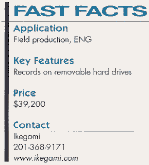|
by Buck McNeely
As the producer/host of
the largest syndicated outdoor-adventure TV series in the nation, "The
Outdoorsman With Buck McNeely.." 1 find myself in some exotic and remote
comers of the globe, shooting under some of the most demanding conditions.
Whether I'm on a one day fishing trip in my home state of Missouri or
on a two-week safari in the African bush, the choice of gear I depend on
is critical.
FEATURES
The original Ikegami Editcam, introduced
more than seven years ago, was an interesting experiment but unusable for
someone in my position. The camera
|
|
light-sensitive (f8.vs.jl1 at 2,000 lux).
The camera can be quickly switched to shoot in either 4:3 or 16:9
aspect ratios through the viewfinder menu. For low- light shooting, the
DNS-201W offers a variety of gain settings that range between -3 dB and
+48 dB.
The DNS-201 takes advantage of virtually all the same digital signal
processing found throughout Ikegami's HL line of cameras. Camera "looks"
are adjusted through the viewfinder menu and stored on one of eight scene
files in the cam- era's memory These can be off-loaded onto an
inexpensive SmartMedia card. Physically; the camera uses the same
chassis that Ikegami builds for its DVCPRO camcorders. The body (without
lens or accessories) weighs 10.5 pounds |
|
seven different compressions,
including AVR- 70BH, AVR- 75, DV50,jFIF 3: 1 and JFlF 10:1, and is
compatible with most Avid NUs. When working with an Avid system, the
thumbnails that represent the clips appear within seconds after the Field-

Pak is mounted to
the system. In most cases, you edit directly from the portable
drive with no transfer or digitizing.
Apart from the door mechanism where the hard drive slides into the
camcorder, the unit has no other moving parts. That's a big upside to this
technology -there is no worry about heads clogging or belts breaking in
places where the nearest service shop is a plane ride away.
The highest -'quality setting available in the Editcam isDV50 (50
Mbps). We recorded in AVR-70BH resolution and AVR-type compression.
IN USE
The Ikegarni DNS-201 W Editcam was outfitted with a FujinonA17x7.8 DERM
lens and a 2X extender. This lens also switches into 16:9 for that
cinematic look. This is an excellent long lens, essential for quality
telephoto shots of wildlife.
For power, I used Anton/Bauer Digital Trimpac batteries. We are now
phasing in the Dionic and lithium-ion-type batteries and find that they
are lighter and provide more run time.
For anyone with experience in this industry, there is a comfort level
with videotape. Making the transition to tape- less acquisition does
require a small shift in thinking, but the process of getting images is
really no different than any other camcorder.
In theory; if the recorder section ever failed, we would just pop in
another Field- Pak. There's not even a dew light on this
|
|
camera and we had
it working in humidity levels that would knot up videotape.
For 95 percent of our shooting, the camera goes on a tripod, a battery
powers the camera and you hit the record button. The radical differences
become apparent only after a closer look.
Anybody who has ever worked on a fishing show knows that if you want a
shot of the host getting a hit on the line, you're either going to bum a
ton of tape or you try to get lucky. The lke Editcam has a unique feature
that offers another solution: a special type of record mode called "Retro
Loop."
This feature actually let us capture events after they
happened. In this mode, the camera writes a "buffer" of time (up to five
minutes) to the disk that's constantly updated. We left the buffer set to
30 seconds.
The Editcam sat in this mode for hours, waiting for a fish to strike.
When the fish took the bait, we hit the record button and began recording
30 seconds prior to that point!
This feature really gives an edge when working with the unpredictable
nature of wildlife & and might work well for a news stakeout, too.
Although most of my shooting is done outdoors and in daylight, the
DNS- 201 W's excellent sensitivity was a real plus. We recorded quite
happily at +9 dB with virtually no noticeable increase in grain.
SUMMARY
In terms of overall quality and usability; the Ikegami DNS-201W
has the features, buttons and capabilities of any modem, professional
three-CCD cam-corder. The difference between the Edit., cam and a
traditional videotape camcorder lies with the Editcam's hard disk
recording.
For us, the Editcam displayed all the convenience and image quality of
a betacamcorder, with the unique capability of hard disk recording. With
the Ikegami Editcam, I shot the best video of my career. .
|
|
was large and heavy, it consumed an inordinate amount
of power and the drives it used were expensive and lacked the recording
capacity that 1 required.
But like most hard drive technology, this has changed tremendously
over the last seven years.
The camera section of the Ike DNS-201W Editcam uses three
520,000-pixel IT CCDs. These are the same chips that are used in the
HL-45W camera. The Edit- cam is also offered in an FIT version (DNS- 21W),
but there is a big difference in price. The IT version is actually a bit
more |
|
and looks pretty much like many other
camcorders on the market. Instead of loading a tape, however, you insert
a hard drive.
The Editcam records on a drive called a FieldPak, a single hard drive
that fits in a shirt pocket and weighs about eight ounces. It is the
recorder section of the camcorder.
Ikegami offers Field Paks in two capacities: 20 GB and 40 GB. At
DV25, these translate in 1.5 and 3-hour record times, respectively.
The DNS-201W records in as many as |


